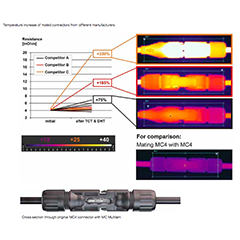Multi-Contact explains why allegedly ‘compatible’ PV cables are so dangerous.
This time, the warehouse burnt down completely. The solar system on the roof of the warehouse had caught fire again. It was the third fire on the 450-square-metre photovoltaic system within the time of just a few weeks. Although the fire service had quickly managed to get the other fires under control, this time they were just too late. The fire had been started by a PV connector becoming too hot. The results: a disaster for the company and a compensation claim against the installer.
Minor cause – big impact
“Every fire is a fire too many,” states Dr. Heribert Schmidt, Project Manager at Fraunhofer ISE. The institute deals with the fire risks of PV systems and reports that, over the last 20 years, there have been 350 fires in the 1.3 million PV systems currently installed in Germany. In 120 cases it was the solar system that caused the fire.
There was major damage in 75 cases, with the building burning down completely in 10. Schmidt continues: “Fires are often caused when inexperienced installation teams install systems on a piecework basis. If the solar connectors are fitted with combination pliers instead of a special tool, or if noncertified connector systems are used, then the weak point is built in from the beginning. System operators should not be making false economies.”
The connectors were to blame for the burnt-out warehouse, too. They became so hot that they caught fire. However, the PV installer had only meant well. He chose plug-in cables that the manufacturer claimed were “compatible” with the module junction boxes. The saving compared to original cables added up to a few hundred Euros. It gave the installer the breathing space he needed to win the bidding war among PV providers.
Looking back, he explains: “The plug-in cables fitted perfectly, and at first glance you could see no difference in terms of colour and finish.” Now he faces a civil suit, the outcome of which could cost him his livelihood.
Compatible does not necessarilymean compatible
Everybody should be aware that TÜV and UL certifications are invalidated if the cable systems fitted are not consistently from a certified manufacturer. Both testing bodies do not approve of combining connectors of different makes. In the case of the catastrophic fire, the installer had relied on the provider’s assurance that its connectors were compatible.
He now realises that that was little more than advertising speak without any real backing. Roman Brück from TÜV Rheinland explains: “Currently, the ‘compatibility’ of PV connectors can only be guaranteed for products in the same range from the same manufacturer or products from contract partners using the same materials and informing one another of any planned changes.”


























